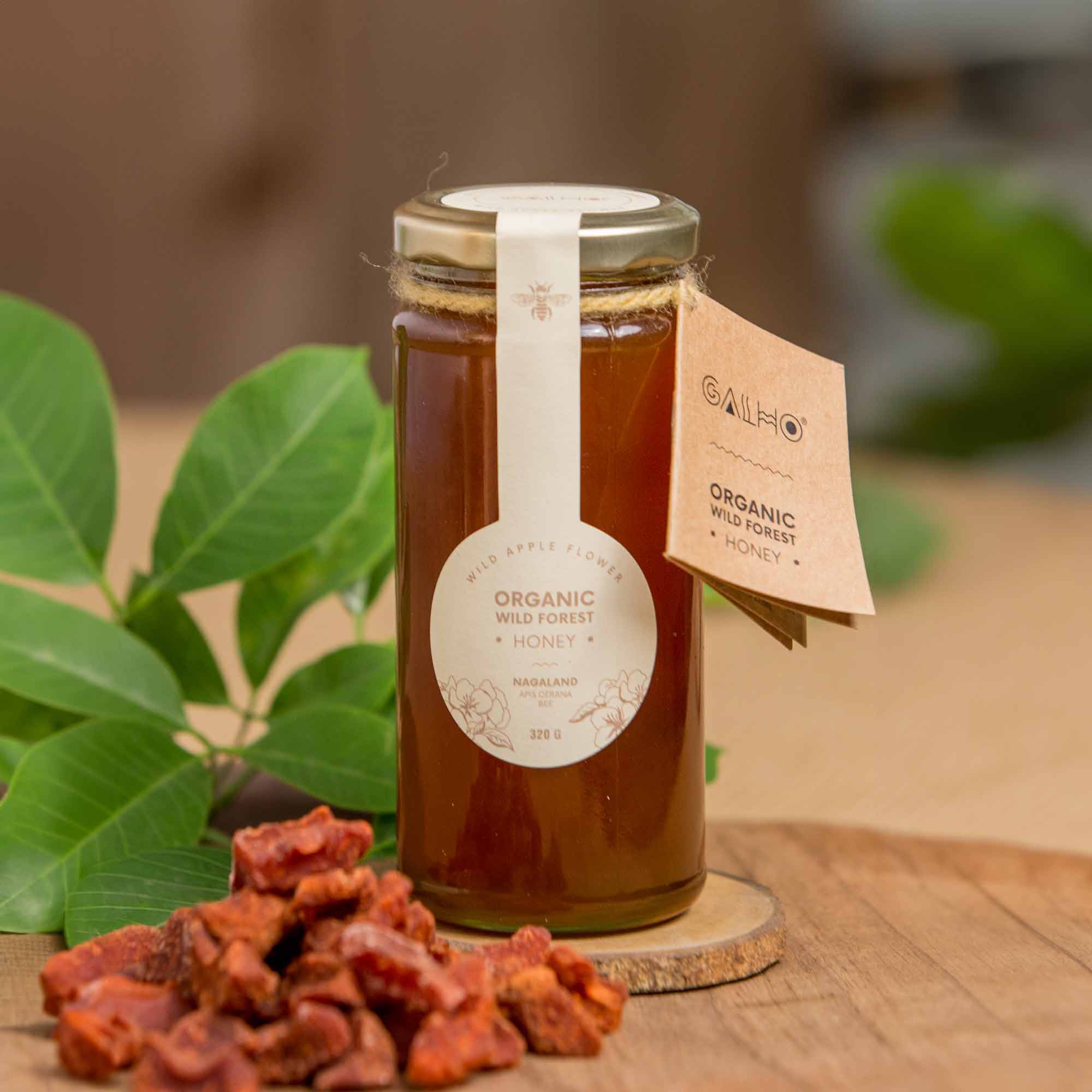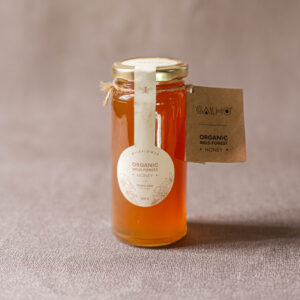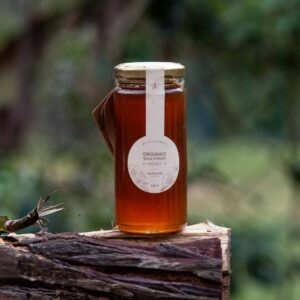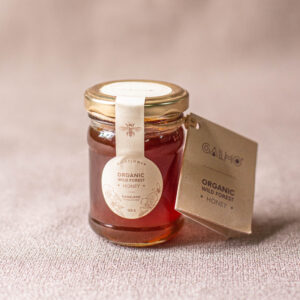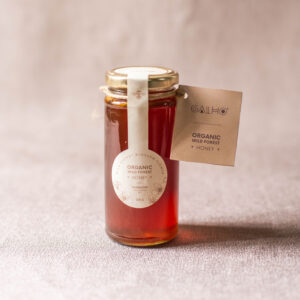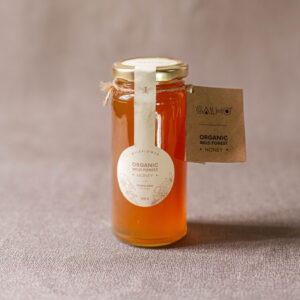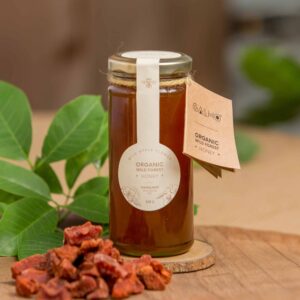In the lush hills of Northeast India, where nature thrives, we share a story of honey made by busy bees and local communities. Galho brings you Nagaland Honey, a pure gift from Nagaland’s beautiful landscape.
Our wild forest honey is more than just sweet – it shows our respect for tradition, nature, and the environment. Follow our honey’s journey from the forest to your home with care at every drop.
The Heart of Galho: A Promise of Purity
At Galho, we honour nature and the local people who have protected it through generations. From the types of bees found in Nagaland, we extract honey from three of them: the eastern honey bees, the stingless bees, and the rock bees. They have made different kinds of honey with unique tastes and health benefits from different flowers around the locality.
Honey from the eastern bee is light and flowery, honey from the stingless bee is savoury, and honey from the rock bee is rich and densely flavoured. Each type of honey shows what makes our region special.
Step 1: Gathering from Nature
Our wild forest raw honey comes from natural beehives found in Nagaland’s pristine forests and cliffs. The bees live freely in the mountains, between 2,500 and 3,000 meters high, far from commercial areas of production. These clean environments, filled with wildflowers and ancient trees, give our Nagaland Honeyits unique taste and health benefits.
Rock Bee Honey
Collecting rock bee honey is especially brave. Apis dorsata, the giant rock bee, often constructs huge combs on rocky cliffs or tall trees. Local villagers, from neighbouring tribes, take considerable risks to obtain this honey.
Using a bamboo ladder, smoke to calm the bees, and a basket, they collect the honey carefully so the bees can return to their hive. This honey-harvesting practice is thus good for the environment and generates earnings for these highly skilled workers.
Stingless Bee Honey
It is honey from stingless bees, referred to as the “Mother of Medicine”, but it is considered to be produced by a rather smaller Tetragonula bee living in the forests of Nagaland. Such small bees, because of their small size, are capable of nectar collection through small flowers, and they produce quite sweet and sour honey. Local beekeepers have retained traditional methods of keeping these bees in log hives or wooden boxes. Some communities in Kohima and Mokokchung have collaborated for responsible harvesting in these areas.
Apis Cerana Honey
Apis cerana honey is aromatic, with a mild, floral sweet smell, collected from controlled colonies from the local beekeepers’ orchards and gardens. These bees are helpful pollinators of several crops, assisting in honey production and local farming. By gathering honey from these varied places, we ensure our Nagaland Honey shows the region’s rich diversity.
Step 2: Responsible Harvesting
We care deeply about nature. Our beekeepers take honey carefully to protect bees in their hives, taking only small amounts so bees have enough to live on. This helps keep both rock bees and stingless bees healthy. When we protect bees and their homes, we allow the forest to thrive and keep our wild honey pure.
Every jar of honey tells a story about its forest source. The honey’s colour changes with seasons and flowers, ranging from clear to dark brown. These natural colour changes show the variety of plants in Nagaland. We’re proud of these differences because they prove our honey is pure and real.
Step 3: Careful Processing
Our wild forest raw honey stays natural because we handle it carefully. We don’t process it like factory honey – we don’t heat it or filter it heavily. We squeeze the honey from the combs by hand and strain it through the cloth to remove wax pieces. This gentle method keeps healthy things like propolis and bee pollen in the honey. By avoiding machines, we make sure the honey stays pure.
This hands-on approach is very strict but necessary for the quality of our Nagaland honey. Each jar is rich in nutrients known for their health benefits. Whether used as a dessert, a remedy for coughs, or a way to boost immunity, our honey brings the essence of Nagaland’s forests.
Step 4: Thoughtful Packaging
We put our honey in different-sized glass jars, which is better for the environment and keeps the honey fresh longer. We carefully fill and pack each jar ourselves before sending it to you.
We make gift baskets with our Nagaland Honey and other great products for special occasions. These gifts let people enjoy our honey while learning about the beekeepers behind it. Our customers love the authentic taste, like Asen from Dimapur, who says our honey reminds him of his grandmother’s pure honey.
The Impact of Galho
When you choose Galho, you support both delicious wild forest raw honey and a bigger cause. We work with more than 100 beekeepers across Nagaland, helping their local communities and preserving their traditional beekeeping methods. We support the Nagaland Beekeeping and Honey Mission’s plan to produce tons of honey each year. Currently, Nagaland produces great tons, and we’re helping increase this amount.
Our honey does more than taste good – it helps nature thrive. Bees help grow one-third of the world’s food by pollinating plants. By supporting local beekeepers, we help grow more food, protect nature, and help people earn better incomes.
A Taste of Nagaland in Every Jar
From daring honey collectors climbing trees to caring beekeepers, Galho’s wild forest honey shows how people work with nature. Every jar of Nagaland Honey brings you the taste of forest flowers, the hard work of local people, and our guarantee of pure honey.
Use it on pancakes, in your tea, or eat it straight from the jar to taste Nagaland’s natural beauty. Check out Galho’s products and be part of our eco-friendly honey journey.
